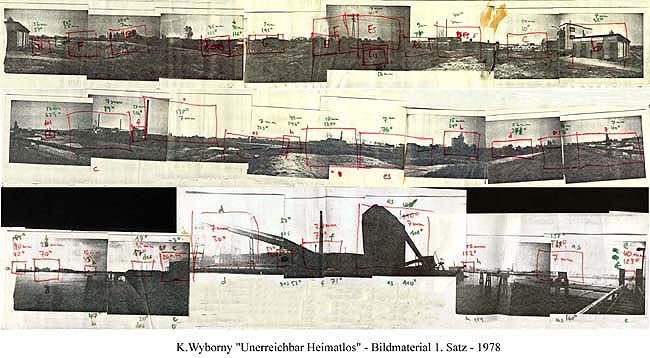
K. Wyborny
(Unreachable Homeless)
Kamera, Buch, Regie: K. Wyborny
(1978, 25 Min 16mm, silent / stumm)

Programm note for Third Avant-Garde Film Festival LONDON 1979:
Could it be true that Bergson's dream of durée in the movies can't be achieved by following the intentions of Lumières patterns? That it can only be reached by misusing an invention that wanted to depict continuous movement and thus carried the tormenting germs of representational time? That only the most terryfying destruction of physical continuity that is achievable by camera operations can give the spectator at least an idea of what durée can mean in film? That the most admirable invention of the narrative cinema, the inevitable and sysrtematic return-cut - usually one of the worst carriers of non-durée - can become the Santa Maria that sails to reconquer the realms of real time? Do you sometimes think that you are invisible? That nobody takes any notice of you? That the only trace of your appearance that is perceived by other people is your despicable body-odour? If these questions and more torment you in your dreams and are a trouble to your days, you mind find a few answers in watching UNREACHABLE HOMELESS. The main character of this film is a person who wakes up one morning and realizes that he is but a robot. In the course of the day his appearance changes and when finally night dissolves his identity, we participate in the most horrendous sexoaesthetic inversion any human has witnessed to date.
Aus einem Interview:
Filmkritik München, Nr.10/1979, S.467, 469
"Die Erfahrung, die ich in der Jetztzeit mache, hat nichts mit ihrer narrativen Aufbereitung zu tun. Die narrative Aufbereitung ist mehr eine Krücke, um überhaupt etwas zu behalten. Ich glaube, Bergson nennt das "durée". Das Phänomen der Dauer von Wirklichkeit, die sich nicht so vom Gedächtnis aufbewahren läßt."
"In letzter Zeit denk ich eigentlich, daß alles schon auf Lumière zurückgeht. Die Schnittidee ist mit der Lumièrschen Erfindung vorhanden, und damit die Zerstörung der durée. Wenn du diesen Filmstreifen anguckst, sind da sowieso von Einzelbild zu Einzelbild lauter kleine Schnitte. Warum soll man da nicht die Filmstreifen aneinanderkleben?"
"Wenn du die durée wiederherstellen willst, mußt du die Lumièrsche Erfindung zerstören. Das ist es eigentlich, was ich in "Unerreichbar Heimatlos" gemacht habe. Ich arbeite nicht auf dem Lumièrschen Prinzip der kontinuierlichen Abbildung von etwas, das sich bewegt, sondern auf dem Prinzip der Einzelbilder. Das ist eigentlich wie Muybridge, nur zusammengebracht auf dem Bildträger, durch das Azetat verbunden."
"Diese Arbeitstechnik pervertiert die Lumièrsche Erfindung. Es gibt keine Ähnlichkeit mehr. Wenn du "Unerreichbar Heimatlos" siehst, erlebst du Jetztzeit. Es gibt da keine Zeit, die abgebildet worden ist."